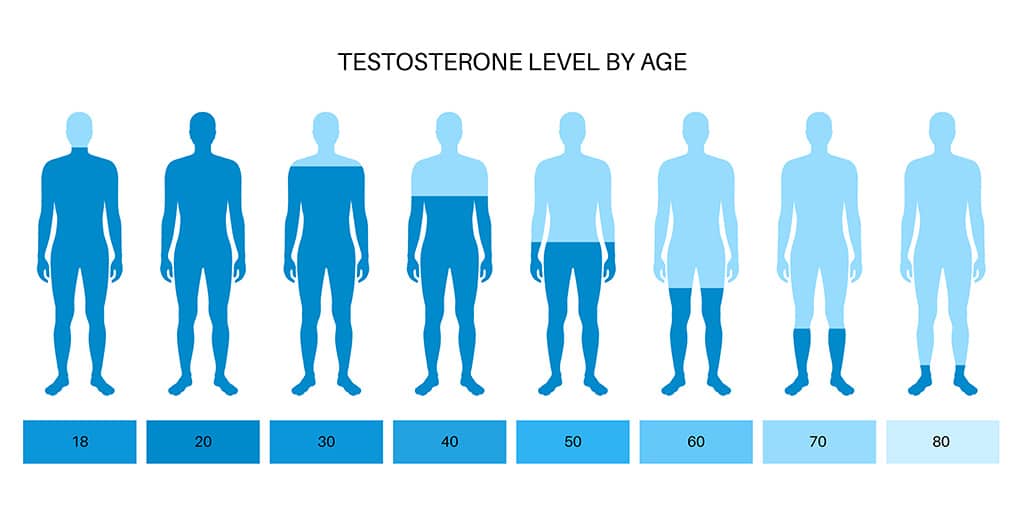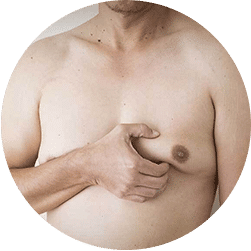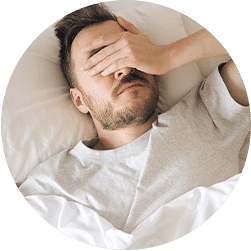
Unlock a More Youthful You With Testosterone Replacement Therapy In Totowa, NJ
Aging is inevitable, and for many, it signals the beginning of a new chapter - one where you cross off bucket list items and live life to the fullest, on your own terms. However, for some men, aging is a horrible prospect, filled with chronic fatigue, irritability, and inability to perform in the bedroom. If you're concerned about life in middle age and beyond, we've got great news: there are easy, proven steps that you can take to help stop the negative effect of aging.
Global Life Rejuvenation was founded to give men a new lease on life - one that includes less body fat, fewer mood swings, and more energy as you age. If you're ready to look and feel younger, it's time to consider TRT (testosterone replacement therapy), and growth hormone peptides. These therapies for men are effective, safe, and customized to fit your goals, so you can keep loving life as you get older.
TRT, and growth hormone peptide therapies bridge the gap between your old life and the more vibrant, happier version of you. With a simple click or call, you can be well on your way to a brighter future. After all, you deserve to be the one in charge of your wellness and health. Now, you have the tools to do so - backed by science and applied by our team of TRT and HRT experts with more than 13 years of experience.

Testosterone Replacement Therapy
- Unlock A More Youthful You With Testosterone Replacement Therapy In Totowa, NJ
- TRT and Anti-Aging Medicine for Men
- Common Symptoms of Low Testosterone
- Benefits of TRT and Anti-Aging Medicine for Men
- Fight Back Against Male Menopause
- Reverse Aging with Growth Hormone Peptides in Totowa, NJ
- Your New, Youthful Lease on Life Starts Here
TRT and Anti-Aging Medicine for Men in Totowa, NJ
For men, getting older comes with its perks, like living life on their own terms and not having to "sweat the small stuff" day in and day out. At the same time, there are aspects of aging that men dread, like hormonal changes. Yes, you read that right – men, not just women, go through hormonal changes as they age. For men, the biggest change involves a drop in testosterone.
Lower levels of testosterone can wreak havoc on a male's mind and body and when left untreated, can result in symptoms like:
- Erectile Dysfunction
- Depression
- Irritability
- Low Sex Drive
- Hair Loss
- Less Muscle Mass
- Problems Concentrating
Those symptoms are concerning, but with testosterone replacement therapy and anti-aging medicine, many males improve their quality of life with age. The good news is that TRT and anti-aging meds aren't only reserved for "old guys." In fact, there's no magic age at which men should start thinking about hormone replacement therapy. Everyone's body is different, so if you're experiencing the above conditions in your mid-30s, TRT could be a viable solution when you consult with a doctor.


What is Testosterone?
Testosterone is a crucial hormone for men and plays an important role throughout the male lifespan. Most of a male's testosterone is produced through the testicles. Also called the male sex hormone, testosterone starts playing its part during puberty.
When a male goes through puberty, testosterone helps males develop:
- Facial Hair
- Body Hair
- Deeper Voice
- Muscle Strength
- Increased Libido
- Muscle Density
As boys turn to men and men grow older, testosterone levels deplete naturally. Sometimes, events like injuries and chronic health conditions like diabetes can lower testosterone levels. Unfortunately, when a man loses too much T, it results in hypogonadism. When this happens, the testosterone must be replaced, or the male will suffer from symptoms like muscle loss, low libido, and even depression.

How Does TRT Work?
TRT is exactly what it sounds like: a treatment option for men that replaces testosterone so that your body regulates hormones properly and restores balance to your life. Also called androgen replacement therapy, TRT alleviates the symptoms that men experience with low T.
Originally lab-synthesized in 1935, testosterone has grown in popularity since it was produced. Today, TRT and other testosterone treatments are among the most popular prescriptions in the U.S.
Without getting too deep into the science, TRT works by giving your body the essential testosterone it needs to function correctly. As the primary androgen for both males and females, testosterone impacts many of the body's natural processes – especially those needed for overall health. For example, men with low T are more prone to serious problems like cardiovascular disease and even type-2 diabetes.
When your body quits making enough testosterone, it causes your health to suffer until a solution is presented. That's where TRT and anti-aging medicine for men can help. TRT helps balance your hormones and replenish your depleted testosterone. With time, your body will begin to heal, and many symptoms like low libido and irritability begin to diminish.

What Causes Low T?
For men, aging is the biggest contributor to lower testosterone levels, though there are other causes like obesity, drug abuse, testicular injuries, and certain prescribed medications. Sometimes, long-term health conditions like AIDS, cirrhosis of the liver, and kidney disease can lower testosterone levels.
When a man's testosterone levels drop significantly, it alters his body's ratio of estrogen and testosterone. Lower testosterone levels cause more abdominal fat, which in turn results in increased aromatase, which converts even more testosterone into estrogen.
If you're concerned that you might have low T, you're not alone. Millions of men in the U.S. feel the same way. The best way to find out if your testosterone is low is to get your levels tested.
For sustainable testosterone replacement therapy benefits, you must consult with hormone doctors and experts like those you can find at Global Life Rejuvenation. That way, you can find the root cause of your hormone problems, and our team can craft a personalized HRT plan tailored to your needs.
Common Symptoms of Low Testosterone
Are you used to blasting through a productive day and accomplishing all your daily goals? Do you find yourself losing muscle mass and the craving to be intimate with your partner? Does your partner complain about how irritable you have become? If you're not usually a curmudgeon, your body could be giving you a sign. It could be time to speak with a doctor about TRT and anti-aging medicine for men in Totowa, NJ.
If you're experiencing any of the following symptoms, you might be battling against low testosterone:

Low Sex Drive
One of the most common reasons that men choose TRT is because they have lost that "spark" with their partner. It's not easy for a man to hear that they're not performing like they used to. Intimacy is a powerful part of any relationship. When a once-healthy sex life dwindles, it can cause serious relationship issues.
The good news is that low libido doesn't have to be a permanent problem. TRT and anti-aging medicines help revert hormone levels back into their normal range. When this happens, many men have a more enjoyable life full of intimacy and sex drive.

Inability to Achieve and Maintain an Erection
Weak erections – it's an uncomfortable subject for many men in the U.S. to talk about. It's even worse to experience first-hand. You're in the midst of an intimate moment, and you can't do your part. Despite being perfectly normal, many men put blame and shame upon themselves when they can't achieve an erection. And while the inability to perform sexually can be caused by poor diet, obesity, and chronic health conditions, low testosterone is often a contributing factor.
Fortunately, weak erections are a treatable condition. The best way to regain your confidence and ability in bed is to speak with your doctor. Once any underlying conditions are discovered, options like TRT may be the best course of treatment.
Hair Loss

Loss of Strength and Muscle Mass
Do you find it harder and harder to work out and lift weights in the gym? Are you having problems lifting heavy items that you once had no problem lifting?
Recent studies show that when men are inactive, they lose .5% of muscle strength every year, from ages 25 to 60. After 60, muscle loss doubles every decade. While some muscle loss is common as men age, a significant portion can be tied to low testosterone levels. When a man's T levels drop, so does his muscle mass.
Testosterone is a much-needed component used in gaining and retaining muscle mass. That's why many doctors prescribe TRT Totowa, NJ, for men having problems with strength. One recent study found that men who increased their testosterone levels using TRT gained as much as 2.5 pounds of muscle mass.
Whether your gym performance is lacking, or you can't lift heavy items like you used to, don't blame it all on age. You could be suffering from hypogonadism.

Hair Loss
If you're like millions of other men in their late 20s and 30s, dealing with hair loss is a reality you don't want to face. Closely related to testosterone decline and hormone imbalances, hair loss is distressing for many men. This common symptom is often related to a derivative of testosterone called DHT. Excess amounts of DHT cause hair follicles to halt their production, causing follicles to die.
Because hair located at the front and crown is more sensitive to DHT, it grows slower than other follicles and eventually stops growing permanently. Thankfully, TRT and anti-aging treatments for men in Totowa, NJ, is now available to address hair loss for good.
While it's true that you can't change your genes, you can change the effects of low testosterone on your body. Whether you're suffering from thinning hair or hair loss across your entire head, TRT and other hormone therapies can stop hair loss and even reverse the process.

Gynecomastia
Also called "man boobs," gynecomastia is essentially the enlargement of male breast tissue. This increase in fatty tissue is often caused by hormonal imbalances and an increase in estrogen. For men, estrogen levels are elevated during andropause. Also called male menopause, andropause usually happens because of a lack of testosterone.
If you're a man between the ages of 40 and 55, and you're embarrassed by having large breasts, don't lose hope. TRT is a safe, effective way to eliminate the underlying cause of gynecomastia without invasive surgery. With a custom HRT and fitness program, you can bring your testosterone and estrogen levels back to normal before you know it.

Decreased Energy
Decreased energy was once considered a normal part of aging. Today, many doctors know better. Advances in technology and our understanding of testosterone show that low T and lack of energy often go hand-in-hand.
If you're struggling to enjoy activities like playing with your kids or hiking in a park due to lack of energy, it could be a sign of low T. Of course, getting tired is perfectly normal for any man. But if you're suffering from continual fatigue, a lack of enjoyment, or a decrease in energy, it might be time to speak with a doctor.
Whether you're having a tough time getting through your day or can't finish activities you used to love, TRT could help.

Lack of Sleep
A study from 2011 showed that men who lose a week's worth of sleep can experience lowered testosterone levels – as much as 15%, according to experts. Additional research into the topic found almost 15% of workers only get five hours of sleep (or less) per night. These findings suggest that sleep loss negatively impacts T levels and wellbeing.
The bottom line is that men who have trouble sleeping often suffer from lower testosterone levels as a result. If you find yourself exhausted at the end of the day but toss and turn all night long, you might have low T.
TRT and anti-aging medicines can restore your T levels back to normal, which can help you sleep better with proper diet and exercise.

Depression
You're feeling down about everything, and there's no solid explanation for why you're in such a crummy mood. Your daily life is great and full of success, but you can't help but feel unexcited and unmotivated. If you're experiencing symptoms like these, you may be depressed – and it may stem from low testosterone.
A research study from Munich found that men with depression also commonly had low testosterone levels. This same study also found that depressed men had cortisol levels that were 67% higher than other men. Because higher cortisol levels lead to lower levels of testosterone, the chances of severe depression increase.
Depression is a very real disorder and should always be diagnosed and treated by your doctor. One treatment option gaining in popularity is TRT for depression. Studies show that when TRT is used to restore hormone levels, men enjoy a lighter, more improved mood. That's great news for men who are depressed and have not had success with other treatments like anti-depression medicines, which alter the brain's chemistry.

Inability to Concentrate
Ask anyone over the age of 50 how their memory is, and they'll tell you it wasn't what it used to be. Memory loss and lack of concentration occur naturally as we age – these aren't always signs of dementia or Alzheimer's.
However, what many men consider a symptom of age may be caused by low testosterone. A 2006 study found that males with low T levels performed poorly on cognitive skill tests. These results suggest that low testosterone may play a part in reducing cognitive ability. If you're having trouble staying on task or remembering what your schedule is for the day, it might not be due to your age. It might be because your testosterone levels are too low. If you're having trouble concentrating or remembering daily tasks, it could be time to talk to your doctor.
Why? The aforementioned study found that participating men experienced improved cognitive skills when using TRT.

Weight Gain
Even though today's society is more inclusive of large people, few adults enjoy gaining weight as they age. Despite their best efforts, many men just can't shed the extra pounds around their midsections, increasing their risk of heart disease and cancer.
Often, male weight gain is caused by hormone imbalances that slow the metabolism and cause weight to pile on. This phase of life is called andropause and happens when there is a lack of testosterone in the body. Couple that with high cortisol levels, and you've got a recipe for flabby guts and double chins.
Fortunately, TRT treatments and physician-led weight loss programs can correct hormone imbalances and lead to healthy weight loss for men.
Benefits of TRT and Anti-Aging Medicine for Men in Totowa, NJ
The benefits of hormone replacement therapy for men are numerous. TRT not only grants relief from low-T symptoms but can help give protection against age-related diseases. Additionally, doctors now recognize male testosterone as an important role in alleviating depression.
Some of the most exciting benefits of TRT can include:
- Reduction in Body Fat
- Increased Strength
- More Muscle Mass
- More Energy
- Lower Risk of Erectile Dysfunction
- Higher Sperm Production
- Healthy Reproductive Tissues
- Lower Risk of Heart Disease and Diabetes
- Lower Risk of Anxiety
- Lower Risk of Depression


Fight Back Against Male Menopause
Because men do not go through a specific period of hormonal changes like women do (called menopause), many doctors refer to "male menopause" as androgen decline. This is just another term for low testosterone, but like female menopause, the symptoms can be serious and affect your quality of life.
The best way to fight back against male menopause is with male HRT treatment from Global Life Rejuvenation. We provide the following HRT treatments for men:
- Testosterone Replacement Therapy (TRT)
- Sermorelin (Sermorelin Acetate)
- Human Growth Hormone (HGH)
Our treatment options are personalized for your body and are available as creams, gels, injectables, and implantable pellets. To find out if testosterone replacement therapy is safe for you, contact Global Life Rejuvenation today to schedule your comprehensive testing and anti-aging treatment consultation.
Reverse Aging with Growth Hormone Peptides in Totowa, NJ
Growth hormone peptides are an innovative therapy that boosts the natural human growth hormone production in a person's body. These exciting treatment options help slow down the aging process and give you a chance at restoring your youth.

What is Sermorelin?
Sermorelin is a synthetic hormone peptide, like GHRH, which triggers the release of growth hormones. When used under the care of a qualified physician, Sermorelin can help you lose weight, increase your energy levels, and help you feel much younger.

Benefits of Sermorelin
Human growth hormone (HGH) therapy has been used for years to treat hormone deficiencies. Unlike HGH, which directly replaces declining human growth hormone levels, Sermorelin addresses the underlying cause of decreased HGH, stimulating the pituitary gland naturally. This approach keeps the mechanisms of growth hormone production active.
Benefits of Sermorelin include:
- Better Immune Function
- Improved Physical Performance
- More Growth Hormone Production
- Less Body Fat
- Build More Lean Muscle
- Better Sleep

What is Ipamorelin?
Ipamorelin helps to release growth hormones in a person's body by mimicking a peptide called ghrelin. Ghrelin is one of three hormones which work together to regulate the growth hormone levels released by the pituitary gland. Because Ipamorelin stimulates the body to produce growth hormone, your body won't stop its natural growth hormone production, which occurs with synthetic HGH.
Ipamorelin causes growth hormone secretion that resembles natural release patterns rather than being constantly elevated from HGH. Because ipamorelin stimulates the natural production of growth hormone, our patients can use this treatment long-term with fewer health risks.

Benefits of Ipamorelin
One of the biggest benefits of Ipamorelin is that it is suitable for both men and women. It provides significant short and long-term benefits in age management therapies, boosting patients' overall health, wellbeing, and outlook on life. When growth hormone is produced by the pituitary gland using Ipamorelin, clients report amazing benefits.
Some of those benefits include:
- Powerful Anti-Aging Properties
- More Muscle Mass
- Less Unsightly Body Fat
- Deep, Restful Sleep
- Increased Athletic Performance
- More Energy
- Less Recovery Time for Training Sessions and Injuries
- Enhanced Overall Wellness and Health
- No Significant Increase in Cortisol
Your New, Youthful Lease on Life Starts Here
Whether you are considering our TRT services, HRT for women, or our growth hormone peptide services, we are here to help. The first step to turning back the hand of time starts by contacting Global Life Rejuvenation.
Our friendly, knowledgeable TRT and HRT experts can help answer your questions and walk you through our procedures. From there, we'll figure out which treatments are right for you. Before you know it, you'll be well on your way to looking and feeling better than you have in years!
 866-793-9933
866-793-9933
Request a Consultation
Latest News in Totowa, NJ
Holiday Parade of Lights to Illuminate Totowa, Woodland Park, and Little Falls
TAPintohttps://www.tapinto.net/towns/passaic-valley/sections/arts-and-entertainment/articles/holiday-parade-of-lights-to-illuminate-totowa-woodland-park-and-little-falls
PASSAIC VALLEY, NJ - The Boroughs of Totowa, Woodland Park, and Little Falls are gearing up for the much-anticipated Totowa, West Paterson, Little Falls Fire Department Holiday Parade of Lights.The holiday festival in Woodland Park is set to dazzle along McBride Avenue from 1 to 4:30 p.m., and promises an array of delights for all ages. Visitors can indulge in a variety of activities, entertainment, and delicious bites from numerous vendors. The event boasts live performances, food trucks, DJ music, and a medley of ac...
PASSAIC VALLEY, NJ - The Boroughs of Totowa, Woodland Park, and Little Falls are gearing up for the much-anticipated Totowa, West Paterson, Little Falls Fire Department Holiday Parade of Lights.
The holiday festival in Woodland Park is set to dazzle along McBride Avenue from 1 to 4:30 p.m., and promises an array of delights for all ages. Visitors can indulge in a variety of activities, entertainment, and delicious bites from numerous vendors. The event boasts live performances, food trucks, DJ music, and a medley of activities tailored for kids. A highlight includes horse and carriage rides from 2 to 5 p.m. and an outdoor ice skating rink open from 1 to 5 p.m.
To usher in the holiday spirit, the Memorial Middle School band will take the stage with live music around 4:30 p.m. just before the grand tree lighting at 4:45 p.m. Welcoming the jolly season, Santa Claus will join the festivity, leading the tree lighting before meeting children at Dowling Gardens.
Sign Up for FREE Passaic Valley Newsletter
Get local news you can trust in your inbox.
This site is protected by reCAPTCHA and the Google Privacy Policy and Terms of Service apply.
The highlight of the day, the Holiday Parade of Lights, will embark from Passaic Valley High School at 5 p.m., traversing through Totowa, Woodland Park, and Little Falls. Over 100 elaborately adorned vehicles and floats will delight onlookers along the route.
One tradition continues as elves stationed along the parade route collect toys for Hackensack Meridian Health, St. Joseph's University Hospital in Paterson, Joseph M. Sanzari Children’s Hospital, and underprivileged families within the community. Donations of unwrapped, new toys can be brought to the parade to spread the holiday cheer.
Woodland Park is also collecting gift cards in any denomination to support those in need. Residents can contribute by placing the gift cards in the designated big red mailbox at the clock tower in Dowling Gardens during the event.
Residents and visitors are advised to expect road closures along the parade route starting around 4 p.m., until approximately 8:00 p.m.
Spectators are encouraged to park in neighborhoods along the route, as well as at 1225 McBride Ave. and the Park West Meadows Shopping Plaza if in Woodland Park. For Little Falls residents, no vehicles will be allowed in or out of the parade area or sections of the Township within the parade route. This includes Main Street between Browertown Road and First Ave, as well as Hopson Ave, Turnberry Road, Tulip Crescent, Van Ness Ave, Sindle Ave, Paterson Ave, and the Entire Jackson Park section of town (including all the side streets in these areas).
As the parade route extends from Totowa Road, running from Hillary Street to Union Boulevard, concluding officially at Crew Street, several streets will undergo closures for parking and traffic management. To alleviate congestion along local streets, organizers encourage attendees to carpool.
The festival will feature a vibrant array of vendors offering an eclectic mix of products, including ornaments, jewelry, candles, photography, pet accessories, and much more.
Can nuns be saved from extinction? Totowa's Little Sisters of the Poor is latest casualty
Deena Yellinhttps://www.northjersey.com/story/news/local/2023/09/26/little-sisters-of-the-poor-leave-nj-as-nuns-face-declining-numbers/70437730007/
5-minute readThis summer, the Little Sisters of the Poor had to admit the sad truth: Their congregation of Roman Catholic sisters, dedicated to helping the elderly, has been shrinking for years. In July, they announced they could no longer staff St. Joseph's Home for the Elderly, the Totowa nursing home where they had cared for thous...
5-minute read
This summer, the Little Sisters of the Poor had to admit the sad truth: Their congregation of Roman Catholic sisters, dedicated to helping the elderly, has been shrinking for years. In July, they announced they could no longer staff St. Joseph's Home for the Elderly, the Totowa nursing home where they had cared for thousands of residents over the last half-century.
The Little Sisters are proud of their long legacy in North Jersey: They began serving the community in 1878, when the order established a home for the elderly on South Eighth Street in Newark that later moved to Dey Street in Paterson. In 1976, they opened St. Joseph's, where a rotating cast of 30 nuns were known for their warmth and selfless care.
In the congregation's heyday in the 1960s, about 5,000 women were members of the Little Sisters of the Poor worldwide. Today, that number has declined to about 1,800, said the Rev. Mark Cregan, an attorney for the order. About 300 remain in the U.S.
Some orders − like the Sisters of Charity of New York, the first U.S. congregation of religious sisters − have stopped accepting new members altogether. Founded in 1817, the community of Roman Catholic women voted in April to begin a "path to completion" after going more than 20 years without successfully recruiting any new entrants.
In July, Mother Alice Marie Monica, provincial superior of the Little Sisters of the Poor said the nuns would withdraw from St. Joseph's, joining the trend of orders around the world that have struggled with dwindling membership.
"After being in New Jersey for 145 years, it is very hard for us Little Sisters to imagine that we will not be serving here in the future," Monica said, adding that the sisters' departure from the home is "a process that has been advancing over the past several years,"
When full, St. Joseph's was home to as many as 250 residents. But as staffing issues have mounted, the census has fallen. By November, the roughly 50 residents still living at the home on Shepherds Lane will move to other senior living facilities, including homes operated by the Little Sisters in other locations.
After that, the Little Sisters will seek a partner to transfer the land and buildings, the Diocese of Paterson said in a statement.
Kevin Sweeney, the bishop of the Diocese of Paterson said he was grateful for their service. "The care of the Little Sisters for the residents for almost a century and a half in our area, following in the line of Saint Jeanne Jugan, has placed love at the heart of their home. The Little Sisters have taught us to be rooted in faith and joyfulness and will ever have our gratitude."
Around the country, other congregations have made similar calculations. With the nun population shrinking, convents are closing or merging − and charities they staffed and supported have closed with them or transitioned to new management.
Will nuns go extinct? The numbers don't look good
In 1966, there were over 180,000 nuns in America. During that era, nuns played a vital role in Catholic schools, orphanages, and senior homes. But interest in the vocation has been waning for decades and today there are fewer than 35,000, according to the Center for Applied Research in the Apostolate at Georgetown University (CARA), which studies the Catholic Church.
Many of today's nuns are over 70 and few young women are replacing those who retire or pass away.
At one time, being a nun was a popular career choice for young Catholic women who wanted to teach, work in a hospital or help the poor − and who were shut out of other professions in a male-dominated society. But these days, with an array of career options available, vows of poverty, chastity and obedience don't seem to hold as much allure.
Sisterly love:Caldwell nuns have lived for a century and been friends nearly as long
"It used to be a badge of honor to have sons who were priests and daughters who were nuns," said Margaret McGuiness, a professor of religion at La Salle University in Philadelphia.
In the mid 1960s, nuns began to reexamine their missions, and many decided they didn't want to be limited to teaching or to wearing the habit, she said. "Sisters in some congregations began going out into the community and doing other types of work involving issues of social justice and advocacy." As a result, more Catholic women left religious life and fewer entered, she said.
Local orders closing down
The Monastery of the Dominican Nuns of the Perpetual Rosary in Camden closed in 2013, while the Sisters of Sorrowful Mother closed St. Francis Residential Community in Denville in 2021 and sold their property to a nonprofit healthcare company. The sprawling brick complex was demolished at the end of last year to make way for a more modern senior living complex.
Just to the south in Morris County, the former St. Ann Villa in Florham Park, long a home to aging Sisters of Charity, was also closed, the Diocese of Paterson announced in 2021. The nursing home, founded in 1930, was transferred in 2016 to Lutheran Social Ministries of New Jersey in a last-ditch attempt to keep it open.
In New York, the Sisters Servants of Mary in the Bronx, which has served the sick for nearly a century, is also closing its doors. At its height, the convent had around 30 sisters who visited and cared for the sick. But that number had dwindled to just three as of June.
A trickle of interest may keep religious orders going
The Sisters of Charity − an order founded by Elizabeth Ann Seton, the first U.S.-born Catholic saint − announced it would close to new members after deciding it no longer had the capacity to carry out its ministries or train newcomers, known as vocations. The order boasted of more than 1,300 nuns in the 1960s but its ranks had diminished to 154 as of April.
Polls show that young people today don't feel the same draw to religion as their parents and grandparents did. The media is replete with articles − from the the New York Times to Fox News - warning that nuns may be headed toward extinction.
But Mark Gray, a senior research associate at CARA, said that nuns won't disappear. Although their ranks are declining, congregations of sisters continue to draw new blood, albeit it in smaller numbers than before, he said. In 2021, 136 women in the U.S. entered religious life, he said, and between 2015 and 2021, 1279 women became nuns.
He attributed the steep decline to a period of "extraordinary growth in the Catholic Church in 1965 when the number of sisters peaked. That was far from the historical norm and the church received decades of service from these women." After that point, new entries slowed, he said.
More:A NJ pastor's coming-of-age tale about young priests makes its big-screen debut
A Gen X sister: 'We are not afraid for our future'
Sister Susan Francois of the Congregation of the Sisters St. Joseph of Peace in Englewood Cliffs, a 51-year-old self-described "Generation X Catholic Sister," said that while large orders may be a thing of the past, "that doesn't mean religious life is going away."
"When I entered the congregation in 2005, most of the sisters were 30 or 40 years older than me," she said. "But I felt like this community was a gift. It was a group of women of all ages and cultures who share the common desire to promote peace, which is our congregation's mission. I can't explain the difference it's made in my life, knowing that you are not alone. There's so much isolation in the world. I always have my sisters. We are committed to each other for life."
Although the congregation is unable to replace all its older members as they age, it is actively inviting new members, and small numbers of young women are responding. Two young women in their 20s are scheduled to join later this month, Francois said.
"We are not afraid for our future."
Correction: A prior version of this story incorrectly said the Sisters of Charity of New York founded the College of St. Elizabeth in Morris County. The college was in fact founded by a different order, the Sisters of Charity of St. Elizabeth. While the Sisters of Charity of New York has voted to stop taking new members, the Morris County order is "alive and well," a spokeswoman said on Tuesday.
Deena Yellin covers religion for NorthJersey.com. For unlimited access to her work covering how the spiritual intersects with our daily lives, please subscribe or activate your digital account today.
Email: [email protected]
Can nuns be saved from extinction? Totowa's Little Sisters of the Poor is latest casualty
Deena Yellinhttps://www.northjersey.com/story/news/local/2023/09/26/little-sisters-of-the-poor-leave-nj-as-nuns-face-declining-numbers/70437730007/
5-minute readThis summer, the Little Sisters of the Poor had to admit the sad truth: Their congregation of Roman Catholic sisters, dedicated to helping the elderly, has been shrinking for years. In July, they announced they could no longer staff St. Joseph's Home for the Elderly, the Totowa nursing home where they had cared for thous...
5-minute read
This summer, the Little Sisters of the Poor had to admit the sad truth: Their congregation of Roman Catholic sisters, dedicated to helping the elderly, has been shrinking for years. In July, they announced they could no longer staff St. Joseph's Home for the Elderly, the Totowa nursing home where they had cared for thousands of residents over the last half-century.
The Little Sisters are proud of their long legacy in North Jersey: They began serving the community in 1878, when the order established a home for the elderly on South Eighth Street in Newark that later moved to Dey Street in Paterson. In 1976, they opened St. Joseph's, where a rotating cast of 30 nuns were known for their warmth and selfless care.
In the congregation's heyday in the 1960s, about 5,000 women were members of the Little Sisters of the Poor worldwide. Today, that number has declined to about 1,800, said the Rev. Mark Cregan, an attorney for the order. About 300 remain in the U.S.
Some orders − like the Sisters of Charity of New York, the first U.S. congregation of religious sisters − have stopped accepting new members altogether. Founded in 1817, the community of Roman Catholic women voted in April to begin a "path to completion" after going more than 20 years without successfully recruiting any new entrants.
In July, Mother Alice Marie Monica, provincial superior of the Little Sisters of the Poor said the nuns would withdraw from St. Joseph's, joining the trend of orders around the world that have struggled with dwindling membership.
"After being in New Jersey for 145 years, it is very hard for us Little Sisters to imagine that we will not be serving here in the future," Monica said, adding that the sisters' departure from the home is "a process that has been advancing over the past several years,"
When full, St. Joseph's was home to as many as 250 residents. But as staffing issues have mounted, the census has fallen. By November, the roughly 50 residents still living at the home on Shepherds Lane will move to other senior living facilities, including homes operated by the Little Sisters in other locations.
After that, the Little Sisters will seek a partner to transfer the land and buildings, the Diocese of Paterson said in a statement.
Kevin Sweeney, the bishop of the Diocese of Paterson said he was grateful for their service. "The care of the Little Sisters for the residents for almost a century and a half in our area, following in the line of Saint Jeanne Jugan, has placed love at the heart of their home. The Little Sisters have taught us to be rooted in faith and joyfulness and will ever have our gratitude."
Around the country, other congregations have made similar calculations. With the nun population shrinking, convents are closing or merging − and charities they staffed and supported have closed with them or transitioned to new management.
Will nuns go extinct? The numbers don't look good
In 1966, there were over 180,000 nuns in America. During that era, nuns played a vital role in Catholic schools, orphanages, and senior homes. But interest in the vocation has been waning for decades and today there are fewer than 35,000, according to the Center for Applied Research in the Apostolate at Georgetown University (CARA), which studies the Catholic Church.
Many of today's nuns are over 70 and few young women are replacing those who retire or pass away.
At one time, being a nun was a popular career choice for young Catholic women who wanted to teach, work in a hospital or help the poor − and who were shut out of other professions in a male-dominated society. But these days, with an array of career options available, vows of poverty, chastity and obedience don't seem to hold as much allure.
Sisterly love:Caldwell nuns have lived for a century and been friends nearly as long
"It used to be a badge of honor to have sons who were priests and daughters who were nuns," said Margaret McGuiness, a professor of religion at La Salle University in Philadelphia.
In the mid 1960s, nuns began to reexamine their missions, and many decided they didn't want to be limited to teaching or to wearing the habit, she said. "Sisters in some congregations began going out into the community and doing other types of work involving issues of social justice and advocacy." As a result, more Catholic women left religious life and fewer entered, she said.
Local orders closing down
The Monastery of the Dominican Nuns of the Perpetual Rosary in Camden closed in 2013, while the Sisters of Sorrowful Mother closed St. Francis Residential Community in Denville in 2021 and sold their property to a nonprofit healthcare company. The sprawling brick complex was demolished at the end of last year to make way for a more modern senior living complex.
Just to the south in Morris County, the former St. Ann Villa in Florham Park, long a home to aging Sisters of Charity, was also closed, the Diocese of Paterson announced in 2021. The nursing home, founded in 1930, was transferred in 2016 to Lutheran Social Ministries of New Jersey in a last-ditch attempt to keep it open.
In New York, the Sisters Servants of Mary in the Bronx, which has served the sick for nearly a century, is also closing its doors. At its height, the convent had around 30 sisters who visited and cared for the sick. But that number had dwindled to just three as of June.
A trickle of interest may keep religious orders going
The Sisters of Charity − an order founded by Elizabeth Ann Seton, the first U.S.-born Catholic saint − announced it would close to new members after deciding it no longer had the capacity to carry out its ministries or train newcomers, known as vocations. The order boasted of more than 1,300 nuns in the 1960s but its ranks had diminished to 154 as of April.
Polls show that young people today don't feel the same draw to religion as their parents and grandparents did. The media is replete with articles − from the the New York Times to Fox News - warning that nuns may be headed toward extinction.
But Mark Gray, a senior research associate at CARA, said that nuns won't disappear. Although their ranks are declining, congregations of sisters continue to draw new blood, albeit it in smaller numbers than before, he said. In 2021, 136 women in the U.S. entered religious life, he said, and between 2015 and 2021, 1279 women became nuns.
He attributed the steep decline to a period of "extraordinary growth in the Catholic Church in 1965 when the number of sisters peaked. That was far from the historical norm and the church received decades of service from these women." After that point, new entries slowed, he said.
More:A NJ pastor's coming-of-age tale about young priests makes its big-screen debut
A Gen X sister: 'We are not afraid for our future'
Sister Susan Francois of the Congregation of the Sisters St. Joseph of Peace in Englewood Cliffs, a 51-year-old self-described "Generation X Catholic Sister," said that while large orders may be a thing of the past, "that doesn't mean religious life is going away."
"When I entered the congregation in 2005, most of the sisters were 30 or 40 years older than me," she said. "But I felt like this community was a gift. It was a group of women of all ages and cultures who share the common desire to promote peace, which is our congregation's mission. I can't explain the difference it's made in my life, knowing that you are not alone. There's so much isolation in the world. I always have my sisters. We are committed to each other for life."
Although the congregation is unable to replace all its older members as they age, it is actively inviting new members, and small numbers of young women are responding. Two young women in their 20s are scheduled to join later this month, Francois said.
"We are not afraid for our future."
Correction: A prior version of this story incorrectly said the Sisters of Charity of New York founded the College of St. Elizabeth in Morris County. The college was in fact founded by a different order, the Sisters of Charity of St. Elizabeth. While the Sisters of Charity of New York has voted to stop taking new members, the Morris County order is "alive and well," a spokeswoman said on Tuesday.
Deena Yellin covers religion for NorthJersey.com. For unlimited access to her work covering how the spiritual intersects with our daily lives, please subscribe or activate your digital account today.
Email: [email protected]
Totowa, NJ, Woman Finds Relief From Severe Migraine
hackensackmeridianhealth.orghttps://www.hackensackmeridianhealth.org/en/healthu/patient-perspectives/2023/05/woman-finds-relief-from-severe-migraine
Around the age of eight, Caitlin Webb, now 22, began getting migraines whenever she had her braces adjusted. After starting her period at age 12, the migraines became chronic, and the pain intensified. She’d have extreme dizziness, nausea, vomiting, cold sweats and uncontrollable shaking. “It makes you so fatigued,” she says. “The fatigue lasts forever. It never feels like it goes away.”The ceaseless misery of the headaches upended Caitlin’s life. She had been active in Girl Scouts, took dance class...
Around the age of eight, Caitlin Webb, now 22, began getting migraines whenever she had her braces adjusted. After starting her period at age 12, the migraines became chronic, and the pain intensified. She’d have extreme dizziness, nausea, vomiting, cold sweats and uncontrollable shaking. “It makes you so fatigued,” she says. “The fatigue lasts forever. It never feels like it goes away.”
The ceaseless misery of the headaches upended Caitlin’s life. She had been active in Girl Scouts, took dance classes and played a variety of seasonal sports, but all that was curtailed by migraines.
School became a challenge, too. Often, her peers and even teachers didn’t understand what was going on with her. “We had to do a lot of advocating for her,” says her mother, Diane, “It was very poorly understood that children could be affected by migraines and that these headaches could be of this much consequence to their lives.”
When Caitlin began seeing pediatric neurologists, she learned she had three different types of headaches disorders—migraine, cluster headaches and occipital neuralgia—in addition to several other health conditions.
Over time, she developed coping strategies. She found that sometimes just blowing single notes on her flute made a difference; it helped regulate her breathing and relax her tense body. She also learned that movement, particularly in the cold, such as ice skating, could decrease her pain. “Life hacks in combination with prescribed medications and other co-treatments,” have been essential in managing my headaches,” she says. “But I was still suffering quite a bit.”
Relief at Last
A breakthrough treatment came into her life when she was 19.
Caitlin had begun seeing an adult headache specialist, in part to begin transitioning out of pediatric medicine, but also because her longtime pediatric neurologist had recommended a pain management treatment he couldn’t provide. Caitlin could have seen a pain management specialist in New York, but that would have meant traveling there three times a week from her home in Totowa, New Jersey. Thankfully, she was able to find a headache specialist closer to home: Regina Krel, M.D., director of The Headache Center at the Hackensack Meridian Neuroscience Institute at Hackensack University Medical Center.
Dr. Krel started Caitlin on a pain management treatment, and while she did get some relief, it wasn’t significant. But a new class of medications for preventing migraine—calcitonin gene-related peptide antibodies (CGRP) monoclonal antibodies (mAbs)—became available in May 2018, and Dr. Krel thought those might be worth trying.
Starting the CGRP mAbs produced “miraculous” results, Caitlin says. She was migraine-free for 50 days straight. “It was beautiful,” she says. “With the migraines, I have this brain fog and my words can get jumbled up. But for those first 50 days, I felt like my brain just opened. I was able to think clearly.”
While that stretch of relief hasn’t been repeated in the two-and-a-half years since, between the quarterly CGRP mAbs infusions and her supportive treatment therapies, Caitlin has, at times, been able to reduce her headache days to four a month when she regularly had 25 to 30 a month, says Dr. Krel.
“Migraine is a neurological disorder for which there is no cure at this time,” Dr. Krel says. “Management has to be a combination of preventative therapy, rescue therapy and lifestyle modifications.”
Caitlin understands she’s in it for the long haul, but her current treatment protocol allows her to focus on her college studies and do things she enjoys, like photography, hiking, and searching for geocaches with her boyfriend. “Because the headaches are not constant, they're not as frequent, they're not as intense,” she says. “I do have more freedom now.”
Next Steps & Resources:
The material provided through HealthU is intended to be used as general information only and should not replace the advice of your physician. Always consult your physician for individual care.
Community Rallies Behind Sofie: A Heartwarming Brigade for a Brave Girl
TAPintohttps://www.tapinto.net/towns/passaic-valley/sections/health-and-wellness/articles/community-rallies-behind-sofie-a-heartwarming-brigade-for-a-brave-girl
TOTOWA, NJ - Residents of Totowa and neighboring towns came together Sunday for a brave young girl named Sofie, who is fighting a courageous battle against B-Cell Acute Lymphoblastic Leukemia.On July 8, Sofie received the devastating diagnosis, and since then, she has undergone two surgeries and started chemotherapy.Despite the challenging journey that lies ahead, the outpouring of love and care for Sofie was truly heartwarming, those in attendace said. Over 300 individuals, including community members, neighbo...
TOTOWA, NJ - Residents of Totowa and neighboring towns came together Sunday for a brave young girl named Sofie, who is fighting a courageous battle against B-Cell Acute Lymphoblastic Leukemia.
On July 8, Sofie received the devastating diagnosis, and since then, she has undergone two surgeries and started chemotherapy.
Despite the challenging journey that lies ahead, the outpouring of love and care for Sofie was truly heartwarming, those in attendace said. Over 300 individuals, including community members, neighbors, police, fire, EMT personnel, and other supporters, gathered for the "Sofie Brigade" in a powerful display of solidarity.
Sign Up for FREE Passaic Valley Newsletter
Get local news you can trust in your inbox.
Those who know Sofie describe her as sweet, kind, funny, down-to-earth, and an amazing softball player. Her presence on the field has been dearly missed by her coaches, teammates, and all who have had the privilege of knowing her. Sofie's passion for softball was evident as she could often be found on the field with her teammates, playing her heart out, and generously helping with setup and breakdowns, always with a radiant smile.
"There's nothing more comforting and uplifting than the love from our community," Coach Anna Mazza, who helped organize the brigade said. "We all came together for this one little girl, and it was so incredible to see the outpouring of support for Sofie and her family. We are only just getting started."
Coach Sara Mulroony, who helped organize the brigade as well, echoed the sentiment, calling the community's rally around Sofie "amazing."
"The Borough of Totowa and surrounding towns really showed their true colors of unity and love for one another,: Councilman Sanders Reynoso said. "Sofie's journey has just begun and we showed that we will be there supporting her and her family in every step of the way."
Mark Monteyne, Totowa Borough Recreation Director, emphasized the true power of community teamwork on a mission to spread positive vibes and hope, showing that when called upon, the community steps up for its residents in extraordinary ways.
"There are not enough words to explain how grateful I am to everyone who participated in the parade," Sofie said. "It caught me by surprise, and I loved it! Thank you all so much from the bottom of my heart."
The brigade was a heartfelt testament to the incredible spirit and love within the community. Sofie's journey may have just begun, but she can rest assured that she has an unwavering support system behind her every step of the way.
Those who wish to offer support, can make a donation here.
As Sofie bravely fights her battle, the love and encouragement of her community will undoubtedly serve as a beacon of hope on her journey to recovery.
Disclaimer:


